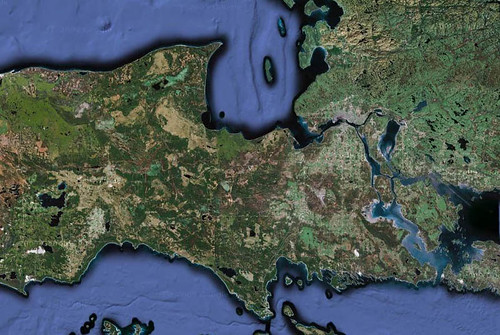 [Images: The forests of northern Michigan, via Google Maps].
[Images: The forests of northern Michigan, via Google Maps].In the woods of northern Michigan, near Hiawatha National Forest, is a massive triangle, unnamed and unlabeled on Google Maps.
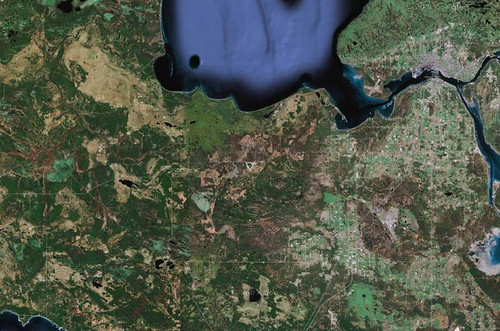
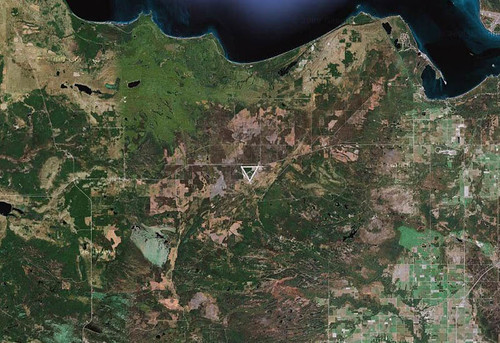



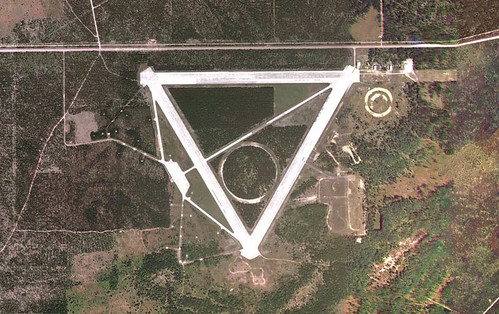 [Images: Geometry amidst the forest, via Google Maps].
[Images: Geometry amidst the forest, via Google Maps].But, despite its anonymity (it even disappears from view altogether when you switch from "Satellite" to "Map"), this is not some underground HQ for a secretive cult of aerially-minded geoglyph-builders, and it's not more scientological circles—it's a former military base and landing-strip complex called Raco Army Airfield.
As it is, the site's monumental geometry, with its northernmost airstrip aligned almost perfectly east-to-west, makes a massive and slightly puzzling triangle in the middle of heavy forest.
 [Image: Raco Army Airfield, via Google Maps].
[Image: Raco Army Airfield, via Google Maps].Raco AAF is a facility that has seen a variety of different uses, according to the website Abandoned & Little-Known Airfields: "The site of the pre-WW2 civilian Raco Landing Field was evidently reused by the military at some point after 1940 for the construction of a much more elaborate military airfield, intended to provide protection to the Sault Sainte Marie locks." However, "As no threats materialized to the locks, the airfield was apparently little-used, or possibly never used at all." Anti-aircraft guns were nonetheless installed on concrete pads in the surrounding forest; these pads remain in the woods today, overgrown with moss and tree roots, offering an unexpected and highly artificial surrogate bedrock for the ecosystem around them.
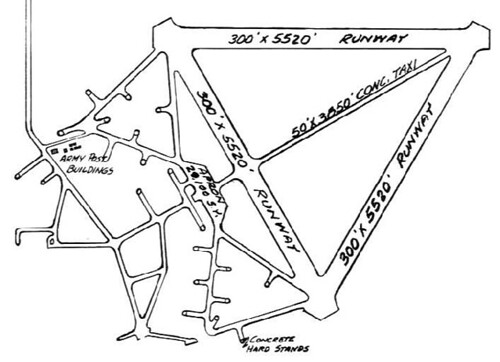 [Image: A plan of the site, via Abandoned & Little-Known Airfields].
[Image: A plan of the site, via Abandoned & Little-Known Airfields].The facility was later armed with nuclear missiles:
- Part of the airfield property was later reused by the Air Force to build a launch site for the huge BOMARC ramjet surface-to-air missiles. The BOMARC was a long-range surface to air missile, intended to shoot down Soviet bombers with a nuclear warhead.
This facility was known as the Kincheloe AFB BOMARC site, and it was manned by the 37th Air Defense Missile Squadron starting in 1960. The BOMARC site was a rectangular installation, just southeast of the runways. It operated the 2nd-generation IM-99B version of the BOMARC missile. The site consisted of a grid of 28 individual missile launcher buildings on the south end, along with larger missile assembly buildings on the north end.
Abandoned & Little-Known Airfields goes on to quote a man named David McLaren: "I visited Raco AAF back in 1974 after spotting it from a B-52 at 20,000 feet. At that time the seedlings had just been planted. The only remaining Air Force structure was a mess hall, which still had the stainless steel coolers & tables. The missile buildings were intact, and although the launching equipment had been removed, the buildings still had their heaters installed."
Some time later, after the field was closed, a "circular automobile testing track" was added to the center of the site, and this was later replaced by a "serpentine vehicle testing track," which you can see in the lower right—the southeast corner—of the above images.
 [Images: The Smithers Winter Test Center].
[Images: The Smithers Winter Test Center].And so the site remains today, oddly: it is intensively reused every winter by a small army of vehicle-testing engineers, who have transformed the facility into the Smithers Winter Test Center. This former military airport, visible as a near-perfectly white triangle hidden amidst the sub-arctic trees, is "ideal for testing and conducting performance evaluations of vehicles, tires and components under the special challenges of extreme cold and hazardous road conditions."
I stumbled across this deep woods triangle—which surely deserves its own Center for Land Use Interpretation listing—while doing otherwise unrelated research with Anya Domlesky, here at the Canadian Centre for Architecture. For more information (and more images), see Abandoned & Little-Known Airfields—but don't miss this much larger aerial shot of the site.
No comments:
Post a Comment